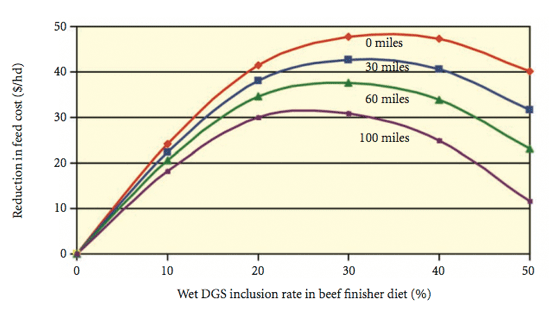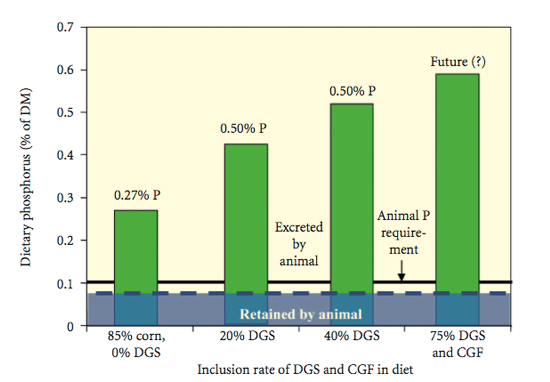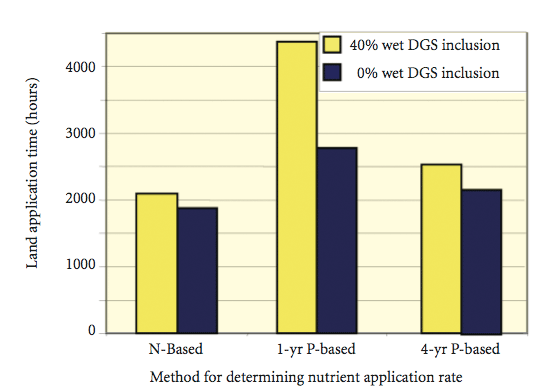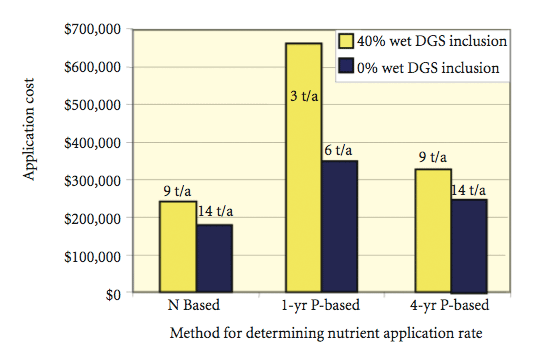



Impact Of Feeding DDG On Beef Farms
The cost benefits of feeding Dried Distillers Grains is expected to cause a rapid adoption by feeding programs according to advice from the University of Nebraska Lincoln.Introduction
Current ethanol industry expansion could significantly affect animal feed management and manure nutrient planning in the beef industry. The economic and performance advantages of feeding distillers grains with solubles (DGS) and corn gluten feeds (CGF) have resulted in rapid adoption of these feeds in beef diets.
Feeding co-product increases nitrogen (N) and phosphorus (P) excretion and effects signi icant changes in land requirements, labor and equipment needs, and manure application rates. A regulatory Nutrient Management Plan (NMP) or a USDA Comprehensive NMP (CNMP) must be adapted to the speci ic levels of distillers co-product feeding in individual cattle feeding programs. This publication summarizes the NMP/CNMP changes necessary when distillers grains co-products are included in a beef ration and introduces implications to public policy. It will evaluate the differences, as diet changes, in excreted manure, land requirements, labor and equipment costs, and value of the manure as a fertilizer.
Benefits and Limitations of Using Distillers Grains with Solubles (DGS) in a Beef Diet
DGS is a feed option that can improve performance and reduce feed cost for beef cattle. The reduction in feed cost when feeding wet DGS has been significant relative to historical average net returns in cattle feeding of $10 per head or less (Figure 1). Distillers grains are high in energy, protein, and phosphorus. Nutrients are typically concen- trated three-fold compared to corn, due to the conversion of starch in corn to ethanol. Increased nutrient levels in DGS can serve as substitutes for other traditional ingredi- ents in the diet. Additional characteristics of DGS may also improve feed intake and help to prevent digestive distur- bances in beef cattle. University research currently suggests limits to the proportion of DGS used in beef cattle rations without compromising performance. Current recommen- dations suggest limiting diet inclusion to 40 percent on a dry matter basis for wet DGS in beef feedlot diets consist- ing of dry-rolled or high-moisture corn, and 20 percent wet DGS for diets based on steam- laked corn (Vander Pol et al., 2006; Corrigan et al., 2007).
Dry distillers grains do not contain as much energy as wet distillers grains, but inclusions of 20 per cent of the diet work well (Buckner et al., 2007b). High dietary sulfur levels may lead to a condition called polio- encephalomalacia (a neurologic disease caused by excess production of hydrogen sul ide gas in the rumen from fermentation) which can be a challenge with high inclusions of DGS. High fat levels in distillers grains may also become a limiting factor for DGS inclusion rates above 40 per cent. However, potential ethanol plant processes for removing sulfur and oil, as well as feeding a combina- tion of DGS with corn gluten feeds may provide oppor- tunities for inclusion rates above the current 40 per cent limit (Loza et al., 2005; Buckner et al., 2007a).
Figure 1. Value of wet DGS relative to a corn-based ration versus inclusion rates and hauling distance from ethanol plant. Assumes corn at $3.50/bu and wet DGS at 95 per cent of corn price based upon 2007 market conditions .

DGS Inclusion Effects on Manure Nutrient Excretion
University of Nebraska–Lincoln research (Geisert et al., 2004) has documented that phosphorus requirements for beef inishers are met by diets containing 0.1 per cent phosphorus (Figure 2). Because corn grain contains 0.3 per cent phosphorus, it is difficult to formulate diets below 0.25-0.30 per cent dietary phosphorus. Diets with DGS and corn gluten feeds will result in phosphorus concentration of 0.4 per cent or greater. The animal does not retain any of the excess dietary phosphorus resulting in all of the excess being excreted in manure. Thus, several aspects of an NMP/CNMP must be adjusted to reflect greater nutrient excretion with higher DGS inclu- sion rates in the diet. To further understand the impact of feeding DGS on NMP/CNMPs, a case study is presented to illustrate these changes for dietary inclusion rates of 0 percent, 20 per- cent, and 40 per cent DGS on a 2,000- and 20,000-head beef open lot production system. The assumptions are summarized in Table 1.
Figure 2. Dietary phosphorus in beef feedlot diets.

Excreted and crop-available nitrogen and phosphorus increase in response to changes in diet (Table 2). Nitrogen excreted increases by 21 per cent to 51 per cent for DGS at 20 and 40 per cent inclusion rates, respectively. The increase in excreted phosphorus is 46 percent and 92 per cent for a 20 per cent and 40 per cent inclusion rate, respectively.
Impact of DGS Inclusion on Nutrient Plan
Several aspects of an NMP/CNMP will need adjustment in order to account for dietary inclusion rates of DGS in beef cattle diets. Failure to consider these nutrient plan changes may produce a plan incapable of achieving intended environmental goals or regulations. As DGS inclusion rates increase, strategic or long-term planning issues should address:
- Greater land requirements.
- Greater travel distances and time requirements for manure distribution, impacting labor and equip- ment needs as well as capital and operating costs.
- Management practices for minimizing soil erosion and runoff for fields receiving higher phosphorus- content manures. Land treatment components of an NMP/CNMP should be reviewed and possibly revised.
In addition, the annual plan (application rates, ields, application methods) will commonly need adjustment as DGS inclusion increases. Some of the key considerations include:
- Book values of nutrient concentration will not be rep- resentative. In addition, past manure samples may not be representative of manure if DGS use has increased. New, farm-specific manure samples will be needed.
- Application rates will need to be recalculated.
- If manure is applied at a nitrogen-based rate, field selection for manure application may need to be reconsidered. Some fields with a higher phosphorus index score may need to transition to a phosphorus- based rate immediately. The transition time for most fields to a phosphorus-based rate will also be shorter due to higher phosphorus applications resulting from nitrogen-based rates.
The following discussion reviews several of these changes for our case studies using 2,000- and 20,000- head capacity beef feedlots.
Implications for Cattle Producers
Land RequirementsLand requirement for manure application is influenced by the proportion of DGS in the diet (Table 3). Adding DGS produces an increase in excreted and crop-available nitrogen. Most of the additional nitrogen excreted in open lot systems will be volatilized as ammonia gas and not crop available. Only a modest increase in land requirement for nitrogen management is needed due to likely volatilization. However, land requirement will increase by 46 per cent and 92 per cent for phosphorus-based manure application for a 20 per cent and 40 per cent DGS inclusion rate (Table 3).
Land required for phosphorus-based applications typically increases by a factor of about four over nitro- gen-based applications (Table 3). If phosphorus-based rates allow an application to meet multiple-crop-year phosphorus use, the number of acres required for any one-year approaches that required for a nitrogen-based rate.
However, because the same land cannot receive manure again for several years, a phosphorus-based rate will require additional land over a four-year cycle when compared to a nitrogen-based plan. In addition, the analysis assumed that manure was only applied prior to corn in a corn-soybean rotation. These factors account for the differences in total and single-year land require- ments observed in Table 3.
Phosphorus-based plans will require roughly 0.25 to 0.50 acre per head for high-yield continuous corn and corn-soybean rotations, if no DGS use is planned. Between 0.50 and an acre per head is needed if feeding a 40 per cent DGS inclusion. Feeding a 40 per cent DGS inclusion and applying manure prior to planting corn only in a corn-soybean rotation (one acre per finished head) requires the most land. Applying manure only to non-legume crops maximizes the nitrogen value of the manure but can add to land requirements for a corn-soybean rotation.
Labor and equipment time is a critical consideration in the management of farm manure and an issue often ignored in a CNMP/NMP. Use of DGS in the diet will require additional time for manure application, if applied at agronomic rates. NMPs/CNMPs will need to account for the additional labor and equipment require- ments as DGS is added to the diet and farms transition from nitrogen-based to phosphorus-based application rates. Spreading manure on a single-year, phosphorus- based application rate also impacts labor and machinery requirements. Failure to plan for these additional labor and equipment needs will create difficulties in imple- menting a proposed NMP/CNMP (Figure 3).
In our two case-study farms, the highest total cost is observed for manure application on a one-year phosphorus -basis (Figure 4). Use of DGS further accentuates the additional manure application cost as cattle operations move from nitrogen- to phosphorus-based plans. The increased cost is much smaller if the transition is from a nitrogen-based plan to a phosphorus- based plan that allows single manure applications of multiple-year phosphorus requirements.
Estimated gross and net value of manure application is shown in Table 4 for 2,000- and 20,000-head capacity beef feedlots. In all situations, the gross value of manure has increased significantly for cattle fed distillers grains. The increased value of phosphorus in manure is significant, assuming that manure can be transported to more distant fields with soil phosphorus deficits and neighboring crop producers value manure at or near its fertilizer replacement value. Phosphorus-based application plans may recover the greatest value from manure because of their ability to gain economic value for all of the phosphorus in manure. Because of the transportation costs and the nuisance issues associated with manure, valuing manure at its fertilizer replacement value is not always possible.
Figure 3. Time (labor and equipment) for manure application vs. method for determining nutrient management rate (20,000-head feedlot, corn-soybean rotation).

Figure 4. Cost of manure application vs. method for determining nutrient management rate (20,000-head feedlot, corn-soybean rotation).

It is plausible for feedlot owners to reap financial ben- efits from feeding and distributing manure resulting from high DGS inclusion rates. Net value increases with the addition of DGS, for all situations (continuous corn and corn-soybean rotations) for our 2,000- and 20,000-head case study feedlots. Net value increased by $10,000 to $33,000 for the 2,000-head example and between $10,000 and $250,000 for the 20,000-head feedlot (Table 4).
The greatest benefit is for phosphorus-based application rates designed to provide for multiple years of phosphorus in a single application. Achieving this increased value will require innovation in manure marketing ; however, the high phosphorus content of manure from feedlots using DGS can be of greater value to neighboring crop producers.
The “nutrient” book value of manure, calculated using both the American Society of Agricultural and Biological Engineers (ASABE) and Natural Resources Conservation Service (NRCS) formulas is shown in Table 2. Book values will commonly produce signi icant errors in estimates of manure excretion and land requirements because the values are based on diets without DGS. Planners and plan reviewers must avoid using book values in NMPs/CNMPs and begin using estimating pro- cedures that re lect the rate of DGS inclusion in the diet. Future efforts to inventory beef cattle feedlots for nutrient planning should include a collection of information on the rate of DGS inclusion, the resulting crude protein and phosphorus content of diets, and performance characteristics of cattle being feed. Regulations and nutrient plans based on book values rather than on excretion model estimates (ASABE, 2006) will significantly underestimate phosphorus content of manure and the land required for application.
Policy decisions relative to the method for determining manure application rates will have significant impact on the labor and equipment requirements and associated costs for implementing a nutrient plan (Figures 3 and 4). For the 2,000- and 20,000-head case-study feedlots, the transition from a nitrogen- based application rate to a one-year phosphorus-based application increases costs by $7 and $11, respectively, per head marketed, at a 40 per cent DGS inclusion rate. That same transition cost is $0.50 to $2 per head marketed if a four-year phosphorus-based application rate is used. Single versus multiple-year phosphorus application rates significantly impact costs and the ability of feedlots to successfully complete this transition.
Phosphorus is not normally mobile in the soil. If the land where manure is applied is not prone to soil erosion, applied manure phosphorus can be banked for use by subsequent crops with little or no environmental impact (Wortmann et al., 2006). The environmental benefits (if any) of applying manure to meet single versus multiple-year crop phosphorus needs should be balanced against the labor, equipment, and economic costs. In addition , it should be noted that if a reasonable fertilizer value can be recovered from the manure, the transition to a phosphorus based application rate should produce economic benefits greater than the additional application costs.
Summary Points
The economic benefits of DGS in beef diets is well established. However, there are multiple implications to the NMP/CNMP that cattle producers and advisors must consider. Key “Take Home Messages” from this discus- sion include:
- Feed cost benefits from feeding DGS in cattle rations will cause a rapid adoption by feeding programs to include DGS, especially wet DGS, at rates currently approaching 40 per cent of ration dry matter.
- Adding distillers grain in beef diets increases excreted nutrients, land requirements, labor and equipment requirements, and manure handling costs.
- NMPs and CNMPs must re lect the degree of DGS inclusion in the cattle feeding program. Use of book values for estimating excretion, land requirements, and manure nutrient concentration will cause significant errors in nutrient plans. Nutrient plans must recognize how feed ration in luences manure charac- teristics.
- The increased cost incurred to manage manure from cattle fed DGS may be offset by the added nutrient value of substituting manure for commercial fertilizers. The opportunity to market manure with higher phosphorus content should increase interest among neighboring crop producers.
- Policy decisions to allow manure application for a single- or multiple-year crop phosphorus requirement has a major impact on costs, labor, and equipment requirements for implementing a nutrient plan. Use of DGS adds to these higher costs; how- ever, use of DGS and the transition to phosphorus- based plans have the potential for increasing manure value by amounts greater than the increased cost of application.



